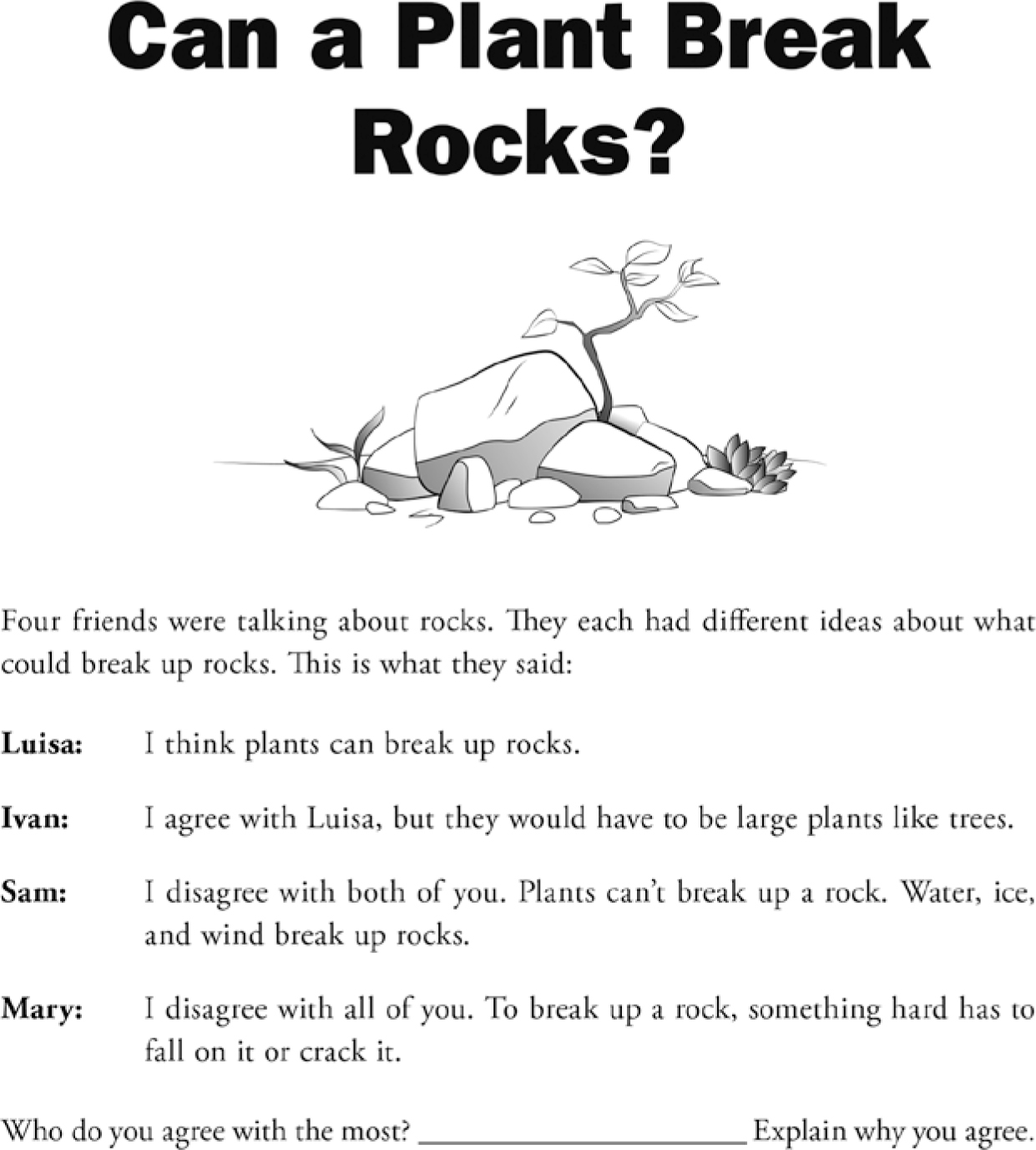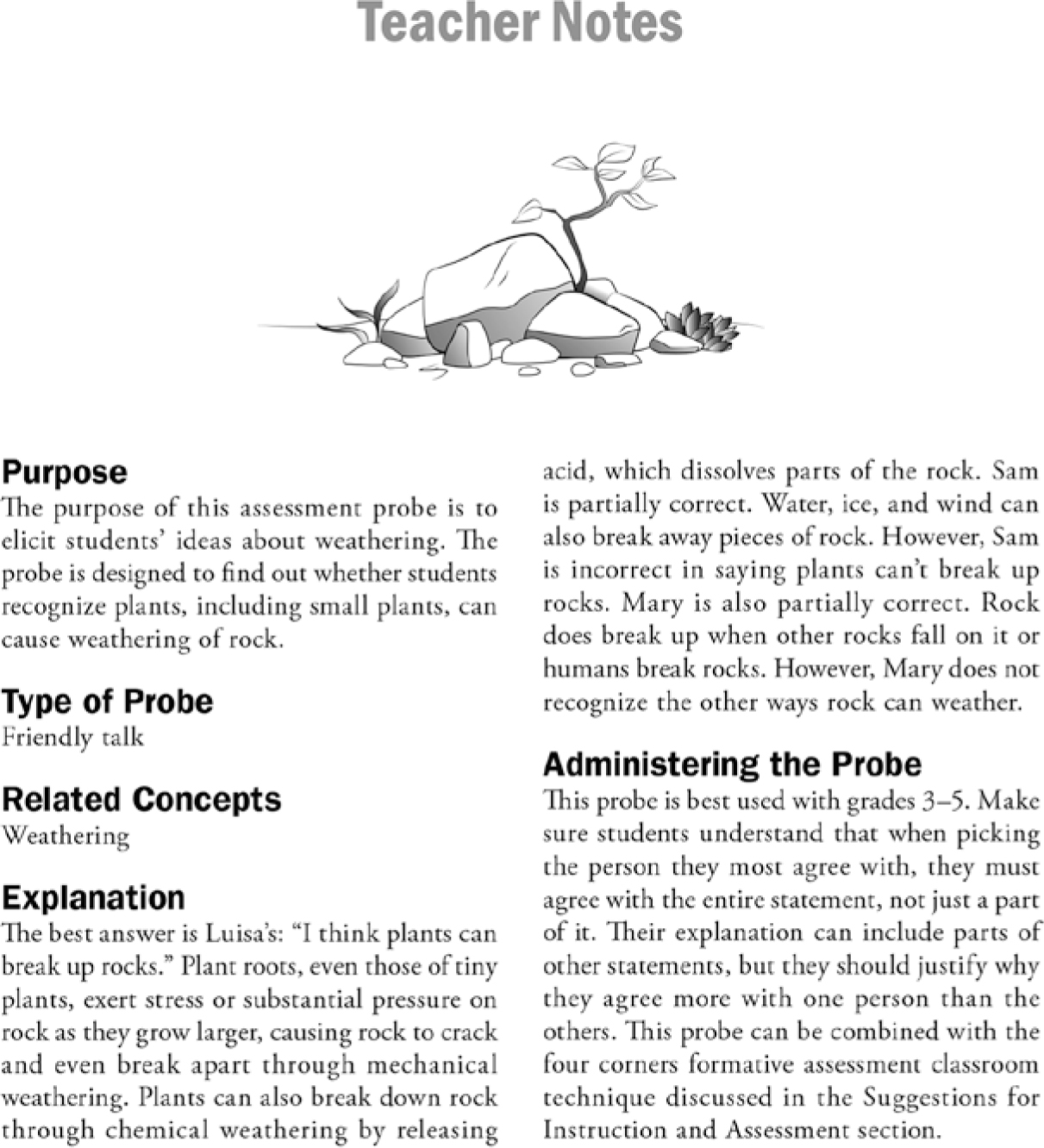Formative Assessment Probes
Our Best Thinking So Far
By Page Keeley
Every formative assessment probe in the Uncovering Student Ideas in Science series has a two-tiered structure. In the first part of a formative assessment probe, students commit to a selected answer choice that reveals how they think about a specific idea or concept. These selected answer choices are based on commonly held ideas from published research studies about how students think about science concepts and ideas. Each probe also includes a second part in which students explain their thinking. This can take the form of written explanations or students can engage in discourse practices, using their explanations to present an argument to support their thinking. Each time a formative assessment probe is used in the classroom, two of the dimensions of the Next Generation Science Standards (NGSS) are always used to support and assess learning: a core disciplinary idea and a scientific practice. There is a third connection to the NGSS when using a formative assessment probe that may not be obvious to you. This third connection is the nature of science and it is central to the intersection between the disciplinary core idea addressed by the probe and the explanation students use to support their answer choice when they revisit a probe after investigating and obtaining more information about the phenomenon.
The NGSS lists eight categories for connecting practices or crosscutting concepts to the nature of science. The category, Scientific Knowledge Is Open to Revision in Light of New Evidence, includes the following elementary learning goals (NGSS Lead States 2013):
Grades K–2: Scientific knowledge can change when new information is found.
Grades 3–5: Scientific explanations can change based on new evidence.
Each of these nature of science connections can be explicitly taught when you embed a formative assessment probe in your lessons. One way to do this is to change your language when referring to students’ answer choices and explanations. Instead of referring to the “right” or “correct” or “wrong” answers, change your language to the “best answer” or our “best thinking so far.” The reason for this is that we want students to understand that their initial ideas are important and give us a starting place to think about, investigate, and learn more about phenomena. It is not about what is “right” or “wrong,” which are also judgmental terms and can send an unintentional message to students who do not get the “right” answer that they are not “good” at science. It is about figuring out the phenomenon with ideas we can start with, understanding that these ideas may change. This is true of scientists as well. Initially, they put their best thinking forward to explain phenomena. As they gather new evidence and information, this thinking may change.
This has happened throughout the history of science as well. Centuries ago, people believed the Sun orbited around the Earth. This made total sense to people at that time based on their observations. They would see the Sun rise in the east and set in the west. Clearly it appeared that the Sun was moving around the Earth. Earth as the center of the universe was also part of the dogma of religious teachings at that time. It wasn’t until astronomers such as Copernicus and Galileo introduced new evidence and were able to explain how the Earth revolved around the Sun that astronomers eventually changed their model of the Earth-Sun system.
Elementary science instructional materials have often been designed to lead students to the “right” answer or outcome without considering how students’ ideas may have changed over the cycle of instruction. Today’s NGSS-designed instructional materials consider the students’ initial ideas about phenomena, provide an opportunity to “figure it out,” revise their initial explanations based on evidence and new information, and reflect on how their thinking has changed. Embedding a formative assessment probe into your lessons provides the opportunity to do this while mirroring the nature of science.
For example, consider the fourth-grade disciplinary core idea ESS.2A: Earth Materials and Systems, “Rainfall helps to shape the land and affects the types of living things found in a region. Water, ice, wind, living organisms, and gravity break rocks, soils, and sediments into smaller particles and move them around” (NGSS Lead States 2013). This includes the idea that plants can break rocks. To begin one of the lessons in an instructional sequence on understanding processes that change Earth’s surface, picture a scenario where a teacher uses the probe, Can a Plant Break Rocks? (Keeley and Tucker 2016; Figure 1) to first elicit students’ initial ideas about whether plants can break rocks.

Using the probe as an initial elicitation, the teacher holds up a small, potted bean plant and asks the class if a plant such as this one can break rocks. She finds the class has different ideas. She asks them to share their best thinking so far about plants and rocks. Some students explain that a plant, like the one she held up, is not strong enough to break a rock. Some students explained that only trees can break a rock because they have big roots. One student supported her choice of Luisa by describing a tree she saw growing out of a crack in a large rock. A few students thought it could only happen if the plant wrapped its roots around a rock and squeezed it. Other students explained how it had to be something “forceful” such as a tree falling on a rock. Eventually the class decided the best answer was Ivan’s because only trees were large enough to split a rock. They explained how a tree seed would fall into a crack in the rock and as the seed grew into a tree, it would split the rock apart once it got big enough. They decided that small plants, like the bean plant were not strong or big enough to break something hard. The teacher recorded all of their ideas as “Our Best Thinking So Far.”
The teacher decided to let the class find out whether their ideas could be supported by observations. Following safety procedures, they filled paper cups with wet plaster of Paris. They pressed two to three bean seeds into the plaster of Paris. The plaster of Paris hardened overnight with the bean seeds in the hard plaster. The next day the students observed the hardened plaster and noticed the bean seeds had swollen. Over the next few days, they observed the germination of the seed and noticed cracks in the plaster. Over several days they saw the cracks widen.
The teacher pointed out the list of their “Best Thinking So Far” and asked if there was anything they would change now. The class decided that small plants could break things that were hard like rocks. They came up with the explanation that pressure from the roots and the emerging seedling was cracking the hard plaster. The teacher then took them outside into the school yard and they looked at areas in the sidewalk where small plants were growing and discussed what would happen to the sidewalk if the plants were allowed to keep growing. To present more evidence of plants cracking rock or things that are hard like rock, the teacher googled images of “driveways with cracks from plants” and “rocks with cracks from plants.” She also found an image of an overcrowded clay pot that cracked from the root pressure of the grasses growing in it. She put together a slide show of the images for students to further discuss as evidence to support the idea that plants can break rocks.
Before starting the next lesson in the storyline of weathering and erosion of rock, the class revisited the probe and had the opportunity to revise their answer choice and construct a new explanation, using evidence from their class activities. The teacher then took the time to emphasize how in science we start with our best ideas and ways of thinking and sometimes these ideas will change as we gather new evidence. Scientists experience this as well. This is how science works in both the classroom and in the real world. She described how we call this the nature of science.
You may have noticed how the language of “best answer” is also reflected in the teacher notes that accompany each probe. Figure 2 is an excerpt from the teacher notes for Can a Plant Break Rocks? (Keeley and Tucker 2016). Notice how the Explanation section of the teacher notes begins with: “The best answer is….” It never starts with “The right (or correct) answer is….”

By emphasizing “best answer to the probe” or “our best thinking so far,” students come to realize that our ideas may change as we gather more evidence. Science isn’t about getting the “right” answer. All ideas are important and should be considered initially. It’s about sharing our best ideas and ways of thinking and then investigating or gathering information to support those ideas. Sometimes we find the evidence supports a different idea, leading to a new explanation. Regardless of the instructional materials you may be using or the lessons you design, using formative assessment probes in this way and changing your language to encourage students’ best thinking will also help them understand the nature of science.


